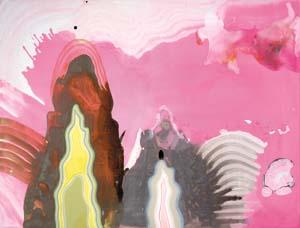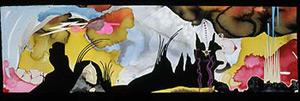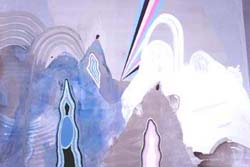
|
||
|
Portland art blog + news + exhibition reviews + galleries + contemporary northwest art
|
||
Anna Fidler - Oblivious Peninsulas Anna
Fidler's new body of work at Pulliam Deffenbaugh is entitled Oblivious Peninsulas. Oblivious Peninsulas represents a point of expansion for the artist as she moves elegantly from cut paper collages into painting, while preserving her personal direction intact through the medium shift.

I haven't been in town long enough to have seen her earlier work, but thanks to my trusty research staff I have been able to get some idea of how this show represents significant growth for the artist. It is significant that peninsulas are places to jump from, and this metaphor elucidates not only this particular point in Fidler's career, but also the relationships she creates between washy, flowing, glittery, lurid, fields of paint and the accreted materiality of the "peninsulas" as objects. Fidler is a polymath musician, artist, and video-maker(thanks Jeff, not only for introducing me to that word, but for taking the time to convince me that it wasn't in fact a synonym for polygon, as I at first believed). Fidler's agility in operating simultaneously in several different arenas while always maintaining her particular artistic phenomenology impressed me. The works relate to one another in poetic resonance and subtle inversion. In the video, abstract felt objects of pure color accrete in stop motion in a perfect, simple pattern on a rocky seashore. It is as if an abstract element of a painting or collage consisting only of form, color and pattern has somehow escaped its boundaries and spontaneously, joyously proliferated among the rocks. It exists among other "natural" life forms that grow teeming among the tide pools. Fidler transmutes compositional principles to primordial, vitalistic forces, and pushes the idea of "art object" towards organism by recontextualizing a single element. 
While non-representative, all of her imagery relates to biology. I found myself thinking simultaneously of landscape paintings and diagrams of the cells and processes of the epidermis. The paintings are subtle inversions of the direction of the video. Here, formal elements of painting (shape/ composition/ color etc.) are seen as vitalistic forces, and the more real, more natural object, the peninsula form, accretes on the surface of the painting intruding into the abstract field. In Fidler's video piece abstract painting elements infiltrate landscape, in the paintings, landscape infiltrates an abstract environment. The peninsulas, built by geologically layering paper and paint extend into nebulous pools of glittery shock pink. The peninsulas evaporate the aura of the picture plane. The surface of the painting becomes liquid and flimsy compared to the assertive materiality of the peninsula. In both the video piece and the paintings, Fidler plays with this tension, juxtaposing the incontrovertible reality of landscape (the hardness of rock) with the indeterminate, responsive aura of abstract painting. It is clear that Fidler views abstract art-making as a responsive practice, the paintings exist for the pleasure of the viewer. Fidler's work is raucously ebullient, fields showered with patterned sprays of pink bubbles and glitter. It is the rectangular equivalent of a wild new year's eve party at the moment right before everyone kisses. Or perhaps a beautifully decorated prom with an under sea theme. 
My research staff informs me that much of her previous work dealt with abstractions and collages derived from under the sea imagery. It is significant, then, that in the peninsula paintings, the perspective has changed. The image now floats just above the surface of the picture plane/ ocean. The picture plane is the ocean, and the peninsula offers a foothold in the real world. Fidler has created a bridge between the material world and the abstract aura, implying that abstract painting is in fact, another kind of environment, not just a set of rule systems and stratagems. Even at the height of the modernist citadel (painting is painting) it was always debated whether or not abstraction could really be free of representation. It seems to me that abstraction, even if it represents nothing directly, always uses the mechanics, or language of representation. There is always something to recognize, even if it is something primordial. In some way, aren't Pollocks also depictions of entangled spaces? Aren't Rothkos also depictions of rarified, spiritualized atmospheres? Fidler plays on the tension in this debate and acknowledges abstract fields as spaces, even providing a more solid place to enter from. It is a complicated issue with her paintings however, because the sea has a surface as well as defining a space. So the paintings end up half in and half out, oscillating between opaque surface and transparent space, generating the same mysterious feeling as standing on a rocky seashore, where the transparency of the ocean hints at its vastness, while its surface makes that vastness inscrutable. There is a foothold from which we can experience the incomprehensible, but no guide to what exactly we are looking at. All we can see is that it is something joyous and flowing. Really elegant moments occur when, within the broad flow of paint, a little angular, geometric rainbow shape briefly emerges only to be pulled back into the current. So Fidler abandons the seriousness of abstract painting as a meaning unto itself without dismantling its history. She acknowledges space and opacity without giving up mystery and then connects it all in to pleasure. It is the pleasure of knowing that some things are beyond our understanding. It is the pleasure of the vast and incomprehensible. And these paintings want to please you, they jump up to be noticed, throw confetti in the air, laugh at your jokes, kiss you on new years. And hasn't pleasure always been important in art, after all? Without sacrificing craft or articulation, Fidler uses joy as an energizing force. Anna Fidler • Oblivious Peninsulas • Nov. 29th to Dec. 30th • (this show ends soon!) Pulliam Deffenbaugh Gallery • 929 NW Flanders St. • Portland, OR • 97209 • 503.228.6665 Posted by Isaac Peterson on December 28, 2005 at 14:32 | Comments (1) Comments I felt it was a successful re-orientation show for Fidler but I see too much Laura Owens meets Laurie Reid meets a little Marc Grotjahn. Despite the successful pastiche there are many good paintings here... The video is good when its kinda supernatural... ala the classic film Picnic at Hanging Rock but it gets bogged down in "Zoom" meets "HR Puff-n-stuff" nostalgia at times too. Overall, I think Fidler needs to shed some of the influences, plus amp up the topography and washes. A little more supernatural mystery in both the videos and paintings might really do the trick too. As for "polymath"... I got lots of shit from Harvard and Northwestern grads for using a word they didnt know a couple years ago but its a good word and it unfortunately showed show up in an ultra pretentious Art Forum piece about a year ago. Personally, I use it as a little homage to the late Minor Meyers jr. who was president of my alma mater as well as president of the polymath society. He was very supportive and engaging... he was only 60 when he died (lung cancer). Frankly, using polymath is easier than compiling some laundry list of disciplines that many creative people naturally accrue. Posted by: Double J Post a comment Thanks for signing in, . Now you can comment. (sign out)
(If you haven't left a comment here before, you may need to be approved by
the site owner before your comment will appear. Until then, it won't appear
on the entry. Thanks for waiting.)
|
| s p o n s o r s |
 |
 |
 |
 |
 |
 |
 |
 |
 |
 |
 |
 |
 |
 |

|
Site Design: Jennifer Armbrust | • | Site Development: Philippe Blanc & Katherine Bovee | |


![[TypeKey Profile Page]](http://www.portlandart.net/nav-commenters.gif)